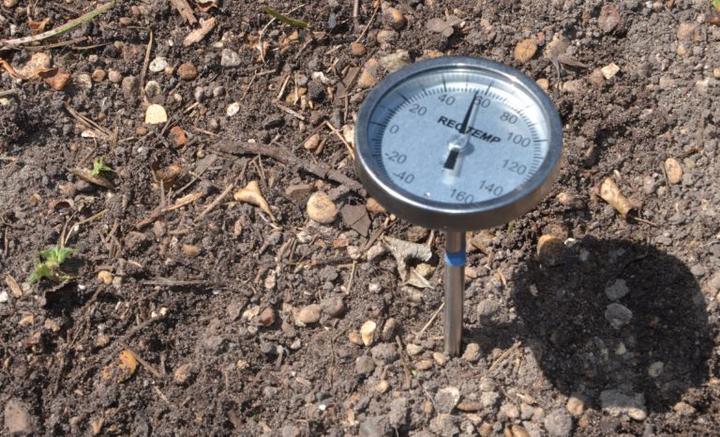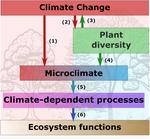SoilDivTemp
 Soil temperature
Soil temperatureSummary
The SoilDivTemp project is aiming to quantify and understand vegetation diversity buffering of soil temperature fluctuations. This project is based on our collaboration with the international SoilTemp consortium, which is compiling near surface temperature measurements around the world, across biomes and ecosystems.

Abstract
The frequency and intensity of extreme climatic events, such as heatwaves and droughts, are increasing with global warming, threatening humanity and other life on Earth. For example, belowground communities and functions are highly sensitive to changes in microclimatic conditions (e.g., temperature and humidity, Gottschall et al., 2019; Cesarz et al., 2020). Yet, vegetation has shown its potential to mitigate external macroclimatic fluctuations by means of buffering processes, assuring smooth transitions between macro- and microclimatic conditions (de Frenne et al., 2019, 2021). Moreover, higher vegetation diversity has been shown to increase primary productivity and the length of the vegetation period (Huang et al., 2017, 2018; Sapijanskas et al., 2014). Therefore, vegetation diversity is expected to increase the macroclimate buffering effect and thus protect belowground communities and functions from dramatic external climatic changes (Gottschall et al., 2019). Here, we propose to quantify the effect of vegetation cover on climatic buffering across ecosystems and seasons using the SoilTemp database and remote-sensing measurements (e.g., NDVI, spectral diversity) as proxies of vegetation diversity. In addition, we propose to quantify the effect of vegetation diversity on climatic buffering across ecosystems across the globe using the SoilTemp database and associated vegetation surveys. In particular, we here aim to understand the mechanisms behind climate buffering of vegetation diversity by investigating the roles of primary productivity and vegetations' spatial and temporal complementarity.
Hypothesis
Our main hypothesis is that vegetation diversity can buffer temperature fluctuations and extreme climatic event, and therefore, reduce the effects of climate change on ecosystems. We are testing this hypothesis using field measurements from the SoilTemp consortium and by linking our results to current research in BEF experiments; such as BEF China and The Jena Experiment.
References
Cesarz, S., Craven, D., Auge, H., Bruelheide, H., Castagneyrol, B., Hector, A., Jactel, H., Koricheva, J., Messier, C., Muys, B., O’Brien, M. J., Paquette, A., Ponette, Q., Potvin, C., Reich, P. B., Scherer-Lorenzen, M., Smith, A. R., Verheyen, K., & Eisenhauer, N. (2020). Biotic and abiotic drivers of soil microbial functions across tree diversity experiments. BioRXiv. https://doi.org/10.1101/2020.01.30.927277
de Frenne, P., Lenoir, J., Luoto, M., Scheffers, B. R., Zellweger, F., Aalto, J., Ashcroft, M. B., Christiansen, D. M., Decocq, G., de Pauw, K., Govaert, S., Greiser, C., Gril, E., Hampe, A., Jucker, T., Klinges, D. H., Koelemeijer, I. A., Lembrechts, J. J., Marrec, R., … Hylander, K. (2021). Forest microclimates and climate change: Importance, drivers and future research agenda. Global Change Biology, 27(11), 2279–2297. https://doi.org/10.1111/gcb.15569
de Frenne, P., Zellweger, F., Rodríguez-Sánchez, F., Scheffers, B. R., Hylander, K., Luoto, M., Vellend, M., Verheyen, K., & Lenoir, J. (2019). Global buffering of temperatures under forest canopies. Ecology and Evolution, 3, 744–749.
Gottschall, F., Davids, S., Newiger-Dous, T. E., Auge, H., Cesarz, S., & Eisenhauer, N. (2019). Tree species identity determines wood decomposition via microclimatic effects. Ecology and Evolution, 9(21), 12113–12127. https://doi.org/10.1002/ece3.5665
Huang, Y., Chen, Y., Castro-Izaguirre, N., Baruffol, M., Brezzi, M., Lang, A., Li, Y., Härdtle, W., von Oheimb, G., Yang, X., Liu, X., Pei, K., Both, S., Yang, B., Eichenberg, D., Assmann, T., Bauhus, J., Behrens, T., Buscot, F., … Schmid, B. (2018). Impacts of species richness on productivity in a large-scale subtropical forest experiment. Science (New York, N.Y.), 362(6410), 80–83. https://doi.org/10.1126/science.aat6405
Huang, Y., Ma, Y., Zhao, K., Niklaus, P. A., Schmid, B., & He, J.-S. (2017). Positive effects of tree species diversity on litterfall quantity and quality along a secondary successional chronosequence in a subtropical forest. Journal of Plant Ecology, 10(1), 28–35. https://doi.org/10.1093/jpe/rtw115
Sapijanskas, J., Paquette, A., Potvin, C., Kunert, N., & Loreau, M. (2014). Tropical tree diversity enhances light capture through crown plasticity and spatial and temporal niche differences. Ecology, 95(9), 2479–2492. https://doi.org/10.1890/13-1366.1


